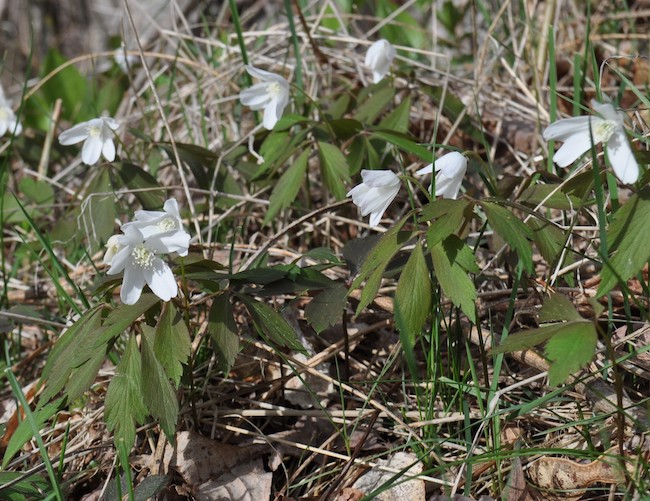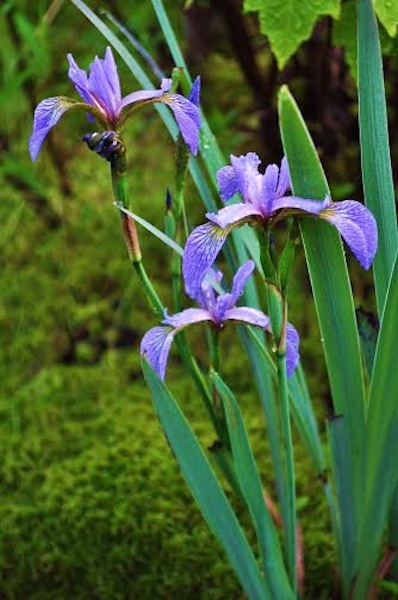In late April Jack will once again be in his pulpit in moist, seaonally wet, lowland areas.
Don't fear the mosquito and don't fear the tick. In our neck of the woods frost is usually gone by the last week in April and does not return until late October/early November. Although mosquitoes are only a nuisance when we are frost free, ticks can lie in wait all year long. Now is a good time to check your supply of DEET or picaridin to repel mosquitoes and tick killing permethrin for your dedicated hiking pants, shoes/boots and socks. Permethrin will kill ticks at any time of the year if they decide to grab you as you walk by. There are many brands of DEET, picaridin and permethrin. All seem to work as advertised.
------------------------------
ACTIVITY ALERT - April's Exploring the Southeastern Massachusetts Bioreserve Walk has been cancelled by Covid-19.
If you go on a solo walk in the forest and you meet someone else out walking the same trail you are on, simply wave and step off the trail to keep the suggested social distancing of at least six feet as they pass.
This Bioreserve cottontail rabbit sends peaceful thoughts on staying safe, plus demonstrates how to wash your hands/paws and keep your social distance. If we listen to this bunny and follow the rules, our group walks will, hopefully, return soon.
------------------------------
INFO ALERT - Solo walking
The voice of nature is always encouraging.
- Henry David Thoreau
COVID-19 social distancing requires we put on hold our group walks and encourage solo ones. Like group hikes, a solo hike in the forest usually improves mood, energy and creativity. Solo hiking, however, has some unique benefits all its own.
Alone, you can walk at your own speed and go directly to a destination or just meander about exploring your surroundings and what you find along the trail. You don't have to rush to keep up with those in the lead and no one is going to accuse you of walking too fast or too slow. Solo walking, especially at this time of the year when leaves are popping from their buds, is a perfect time to learn your forest trees and shrubs and/or identify the many different species of neo-tropical birds returning to our northern forests to spend the summer. Some of us, who may be thinking of wild edibles while out walking area woodlands, note the shrubs and trees that might provide the ingredients for a berry pie or some nutty cookies later on in summer and fall. Always an enjoyable walk in the woods when one can harvest a few berries or nuts.
Pack along some water and snacks. Maybe binoculars and your camera too. To identify the natural stuff also bring along a field guide or two. Great fun to identify other species of flora and fauna that you share your local environment with.
Remember, if you should meet someone else out walking, simply wave and step off the trail to keep the government suggested social distancing of at least six feet as they pass.
Blueberries and huckleberries are closely related and both yummy.
A happy and wild berry pie.
Sweet bowl of blackberries.
Black walnut cookies.
---------------------------------
INFO ALERT - Yes, today is Earth Day but ...Earth Day should be every day of the year!
Thanks to Senator Gaylord Nelson, back in 1970, Earth Day is now celebrated every year on April 22 to show respect and support for our home planet. Unfortunately all too few of us show Mother Earth any respect even on her big day.
In our neck of the woods, not only on Earth Day but also on every other day of the year, we should likewise respect, support, protect and defend the Southeastern Massachusetts Bioreserve, a small example of Earth's natural beauty and the last large forested area in this heavily populated and developed part of our home planet. A good view of the Bioreserve and the developed world that surrounds it can be seen from the top of the Massachusetts Department of Conservation and Recreation, Bureau of Forest Fire Control's Fall River Fire Tower on Copicut Hill. At 356' Copicut Hill is the highest point in coastal Bristol County.
We have organized numerous walks around Copicut Hill and to the fire tower over the years. During dry weather periods the tower is occupied by a fire watcher. If the tower is occupied, the fire watcher will often see you coming and open a window. A shouted request to visit, up to the person on duty, usually leads to an invitation to come on up for a visit and a very educational presentation on a fire watcher's duties and some incredible views. If the day is clear, one can see the two tallest buildings In Boston, the Prudential Tower and the John Hancock Tower to the north, as well as New Bedford, Buzzards Bay and Cape Cod, beyond, when looking south. For more on the Copicut Hill Fire Tower go here: http://nhlr.org/lookouts/us/ma/fall-river-fire-tower/ Occasionally the fire watcher is busy and cannot accommodate you. They do have fires to watch for. If you are denied a tour, say "thank you" and continue your hike.
At this particular time of unfortunate pandemic attack it wouldn't be wise, if hiking by the tower and the tower is occupied, to request a visit. Not a smart thing to do at all. Hopefully, if we continue to follow social distancing and the other suggested or required recommendations, life will return to normal sooner rather than later.
Invited into the fire tower while on an Exploring the Southeastern Massachusetts Bioreserve Walk on Earth Day, a few years ago, we took the following photos:

Looking east over the flat, coastal Bioreserve forest. No mountains on the horizon. Spring comes very slowly in the deep, dark forest. Note the reddish hue on the foreground red maples. Their red buds are about to pop open. By May all forest trees will all be leafing out as if by magic.

Looking southeast across the red maples to the more distant white pines, pitch pine and Atlantic white cedar forest. Part of the Copicut Reservoir is in the center of the photo and way off in the distance is New Bedford, what appears to be the wind turbines on Sconticut Neck in Fairhaven, Buzzards Bay and Cape Cod beyond.

A better view of the objects in this blow-up from the above photo. See that steeple sticking up above New Bedford? What is the name of that church?
---------------------------------------------
INFO ALERT - Get Ready! May is lovely in our neck of the woods
"When April steps aside for May, like diamonds all the ran drops glisten;
fresh violets open every day; to some new bird each hour we listen."
- Lucy Larcom
WOW!!! ...is there a better month to be hiking in New England? High spring and the woods are full of dozens of species of returning migratory birds all attired in their best plumage busily selecting nest sites and defending their territories. Trees and shrubs are leafing out and wildflowers are blooming on the forest floor.
All the leaves popping out and the forest greening up provides plenty of concealing cover for many woodland mammals whose babies were born in March and April and will now be allowed out of their dens following their parents on early morning and late evening hunting excursions learning how to forage food and escape predators.
By late in May the monarch butterflies are back from Florida and Mexico and the green darner dragonflies have returned north too. Now that freezing temperatures are gone until late fall a wide variety of insects in a myriad of shapes and sizes make an appearance. Some spent the winter hidden away as eggs or larvae in woody forest debris or under the duff of the forest floor. Some, like the mourning cloak butterfly survived the winter as adults hibernating in hollow logs and trees.
Mosquitoes will be back too as will pesky springtime black flies. Ticks are out all year long. They are not insects, but arachnids. Don't let any of these pests keep you from enjoying May in the forest, so when hiking in the woods, from May to November, insect repellent containing DEET or picaridin should be carried and dedicated hiking clothes (pants, socks, shoes/boots) should be treated with permethrin.
Wild geranium
Lady's slipper. A member of the orchid family.
A white tail deer fawn hiding in the forest. Its mother knows where she left it when she went off to feed. If you find it, don't touch! It is very tempting to pick up a baby that appears lost or abandoned. Don't do it. Deer fawns are virtually scent free for a purpose. Human scent left on a fawn might make the doe abandon her baby and will attract passing coyotes, foxes, bobcats, fishers, etc. who would gobble that baby up.
Northern watersnake
Wild strawberry
Blue flag, a wild iris
Eastern garter snake (a Liz photo)
Carolina wren in her nest keeping her eggs warm.
A female box turtle looking for a good sunny spot to lay her eggs.
Spicebush swallowtail butterfly sucking nectar from a feral day lily flower.
The cowbird is a bird of the Great Plains that moved east when the great eastern forests were destroyed. They are a terrible plague on warbler, vireo and other small bird species.
Chicken mushroom
Whitetail deer in its reddish-brown summer coat. Deer are grayish-brown with thicker hair insulation in the winter.






































Social